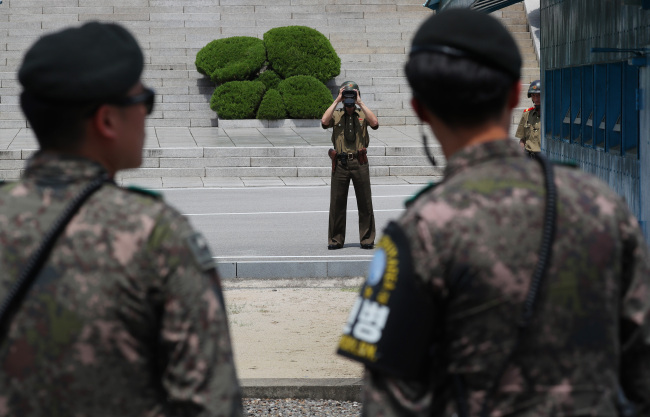[Newsmaker] Soaring land prices could prevent possible troop withdrawal from DMZ
Long road ahead for building trust and arms reduction with North Korea
By Yeo Jun-sukPublished : July 22, 2018 - 18:44
The two Koreas’ efforts to ease military tension along the border may be hampered by unexpected obstacles – including the vicissitudes of the real estate market.
At the April 27 inter-Korean summit, the leaders of the two Koreas pledged to ease tensions, feeding speculations that South Korea’s military is preparing to reduce its presence across the border.
Among possibilities being raised is the pulling back of forward-deployed troops near the heavily fortified Demilitarized Zone, particularly the Marine Corps’ 2nd Division and Army’s 7th Mechanized Corps.
At the April 27 inter-Korean summit, the leaders of the two Koreas pledged to ease tensions, feeding speculations that South Korea’s military is preparing to reduce its presence across the border.
Among possibilities being raised is the pulling back of forward-deployed troops near the heavily fortified Demilitarized Zone, particularly the Marine Corps’ 2nd Division and Army’s 7th Mechanized Corps.

However, even if related plans are approved by the South’s military -- provided the two Koreas have built sufficient trust and North Korea has made progress on denuclearization -- there is another big obstacle that must be overcome: soaring land prices.
“Even if those troops wanted to move to other regions, there is no place to accommodate them,” said a defense official who requested anonymity due to the sensitivity of the issue.
“The Army’s major units are forced to be stationed near the DMZ because land prices are so high in the rear area.”
With the two Koreas still technically at war, most South Korean military units are stationed close to the border with North Korea. About 70 percent of Army units are located in northern Gyeonggi Province and the mountainous Gangwon Province.
Because of the risks of possible skirmishes and military restriction, land prices in those areas are much lower than the “rear area” -- regions south of Seoul and the surrounding area.
Furthermore, the composition of Army units will make it more difficult to find suitable places to accommodate them in the rear area, experts said.
Instead of being clustered into one massive base like the US military’s Camp Humphreys in Pyeongtaek, Gyeonggi Province, most South Korean Army units have their own garrisons across the border from North Korea.
Even if the military managed to find a place to accommodate those forward units, challenges remain for a relocation plan: strong opposition from residents living near prospective garrisons.
“For most South Koreans, military bases are still considered undesirable facilities. Think of what happened when the military tried to station an anti-missile battery and an Air Force base,” said Kim Dae-yong, a military analyst at the Korea Research Institute for National Strategy in Seoul.
When the government announced its plan in 2016 to station the US military’s Terminal High-Altitude Area Defense anti-missile system in Seongju, North Gyeongsang Province, massive protests broke out to prevent the deployment process.
The South Korea and US militaries said the missile defense system was crucial to defending the country from North Korea’s missile threats, but residents feared it would threaten their health and ruin the agricultural economy.
There were also massive protests in 2017 when the government decided to relocate an Air Force base from Suwon, Gyeonggi Province, to the neighboring city of Hwaseong. Hwaseong residents objected to the plans over concerns they would suffer from noise from the air base.
“Once a military base is stationed at a certain place, development of neighboring areas is restricted. I don’t think the people want to see fighters taking off when they are at work and tanks rolling around their neighborhood,” analyst Kim said.
Debate over possible relocations of troops offers a snapshot of challenges for arms reduction. While the two Koreas fully restored military communication lines in the West Sea, there appear to be numerous tasks left before sufficient trust can be established between the two sides.
Confidence-building measures form a broader idea than resuming suspended military communications, involving more proactive measures to boost transparency, such as opening up of training schedule and troop movement, according to analysts.
But the steps the two Koreas have taken so far appear to fall short of reaching such goals. Despite a series of cross-border military talks, the two Koreas failed to come up with dramatic measures to reduce military tension.
“Building trust in the military issue can’t achieved by simply restoring military communication lines. It needs to involve the revelation of military capabilities, participation in military exercises,” said Kim Yeol-su, head of security strategy at the Korea Institute for Military Affairs.
Experts also warned against possibilities that the military might accelerate efforts on arms reduction without significant indications that North Korea has made progress on abandoning their nuclear arsenal.
The Defense Ministry recently suspended its scheduled construction of military facilities close to the DMZ. The decision was aimed to avoid “sunk costs,” which can be incurred by demolishing those facilities in the event of major breakthrough between the two Koreas, military officials said
“Nuclear capabilities best reflect the two Koreas’ military imbalance. That is why progress on denuclearization should be a starting point for building trust with North Korea,” said Shin Beom-chul, a senior fellow at the Asan Institute for Policy Studies.
By Yeo Jun-suk (jasonyeo@heraldcorp.com)









![[Today’s K-pop] BTS pop-up event to come to Seoul](http://res.heraldm.com/phpwas/restmb_idxmake.php?idx=644&simg=/content/image/2024/04/17/20240417050734_0.jpg&u=)

![[Graphic News] More Koreans say they plan long-distance trips this year](http://res.heraldm.com/phpwas/restmb_idxmake.php?idx=644&simg=/content/image/2024/04/17/20240417050828_0.gif&u=)





![[KH Explains] Hyundai's full hybrid edge to pay off amid slow transition to pure EVs](http://res.heraldm.com/phpwas/restmb_idxmake.php?idx=652&simg=/content/image/2024/04/18/20240418050645_0.jpg&u=20240419100350)

